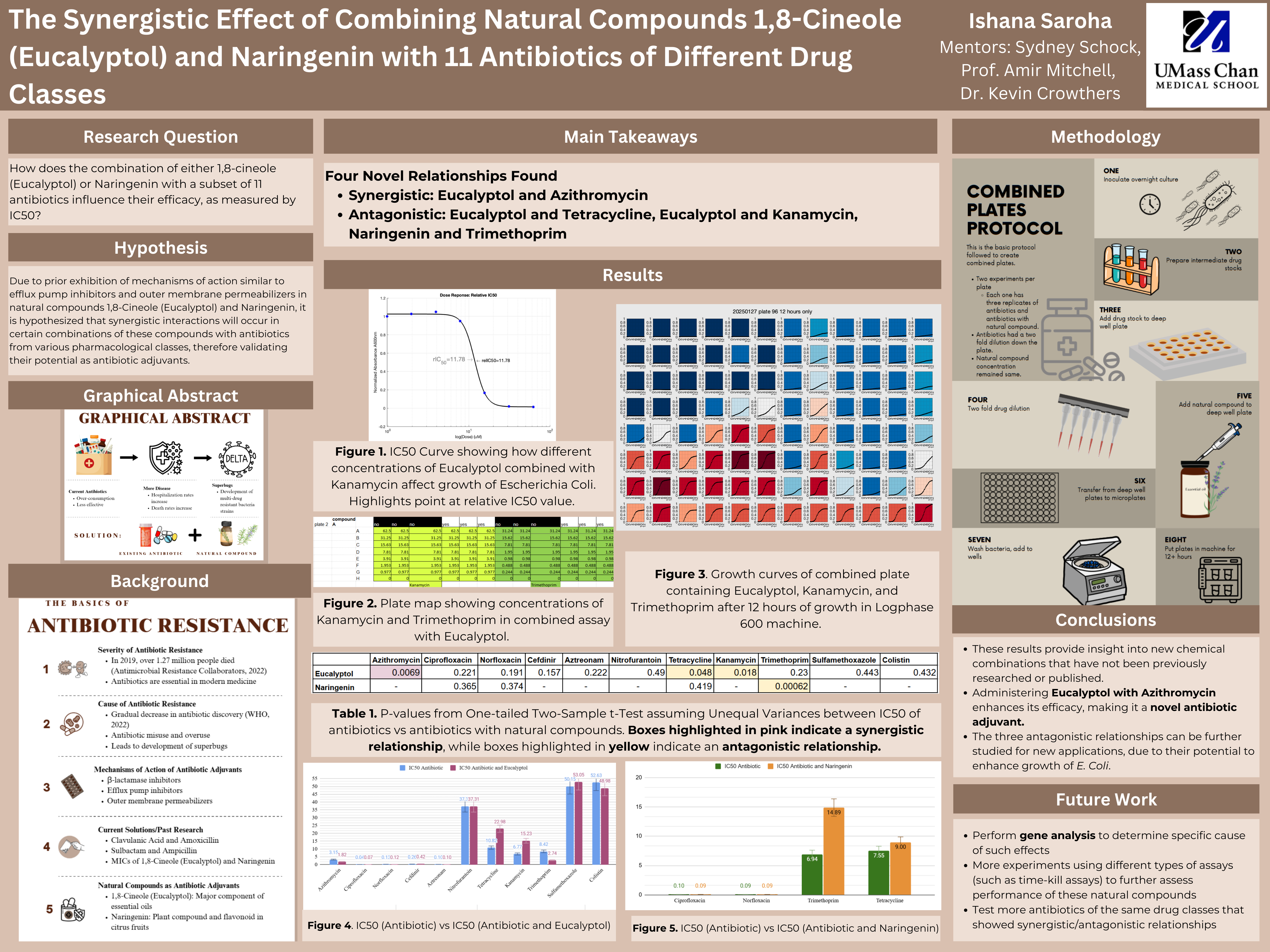STEM I with Science and Technical Writing, taught by Dr. Crowthers, helps students navigate through their six month long independent research projects. In this course, students are taught to brainstorm research project ideas, develop solutions to various problems, and develop proper testing methods for results. Feel free to scroll down to learn more about my independent research project.
The Synergistic Effect of Combining Natural Compounds 1,8-Cineole (Eucalyptol) and Naringenin with 11 Antibiotics of Different Drug Classes
This study explores the potential of two natural compounds, 1,8-Cineole (Eucalyptol) and Naringenin, as antibiotic adjuvants to combat antibiotic resistance. By combining these compounds with eleven different antibiotics, the research aims to assess their antibiotic efficacy and evaluate potential synergistic or antagonistic effects on Escherichia coli using various assay methods. Eucalyptol and Naringenin, known for their antimicrobial properties and mechanisms similar to efflux pump inhibitors and membrane permeabilizers, respectively, were found to enhance the efficacy of some antibiotics, in the combination of Eucalyptol and Azithromycin, while showing antagonistic interactions with others, specifically when combining Eucalyptol with Tetracycline, Eucalyptol with Kanamycin, and Naringenin with Trimethoprim. The results suggest new strategies to restore the effectiveness of existing antibiotics and offer avenues for further research on novel compound combinations.
Abstract
Abstract
Antibiotic resistance represents a critical global health threat, as increasingly prevalent bacterial infections become more challenging to treat with existing antibiotics. Millions of lives are lost to infections caused by antibiotic-resistant bacteria, highlighting the urgent need for innovative strategies to combat this resistance. This study investigates the efficacy of two natural compounds, 1,8-Cineole (Eucalyptol) and Naringenin, in combination with eleven antibiotics of various drug classes, as antibiotic adjuvants to enhance the efficacy of existing antibiotics to combat resistance. Both compounds exhibit antimicrobial properties and are known to have mechanisms of action similar to efflux pump inhibitors - Eucalyptol has demonstrated antimicrobial effects through membrane disruption - and membrane permeabilizers - Naringenin damages bacterial membranes. The aim of this research is to evaluate the synergistic effects of these natural compounds against Escherichia Coli, as there is no current research on potential effects of combining these specific compounds with any antibiotics. Using broth microdilution assays and a derivative of checkerboard assays, Minimum Inhibitory Concentration (MIC) values, Area Under Growth (AUC) values, and Inhibitory Concentration 50% (IC50) values will be compared to identify any potential synergistic interactions. It is hypothesized that both Eucalyptol and Naringenin will enhance antibiotic effectiveness. Results of this study demonstrate a synergistic effect occurred when Eucalyptol was combined with Azithromycin. In contrast, antagonistic interactions were found when Eucalyptol was combined with Tetracycline and Kanamycin, and when Naringenin was combined with Trimethoprim. This research holds significant implications for addressing the growing challenge of antimicrobial resistance by identifying novel compound combinations for restoring efficacy of existing antibiotics, and by expanding potential for new combinations for other applications.
Graphical Abstract
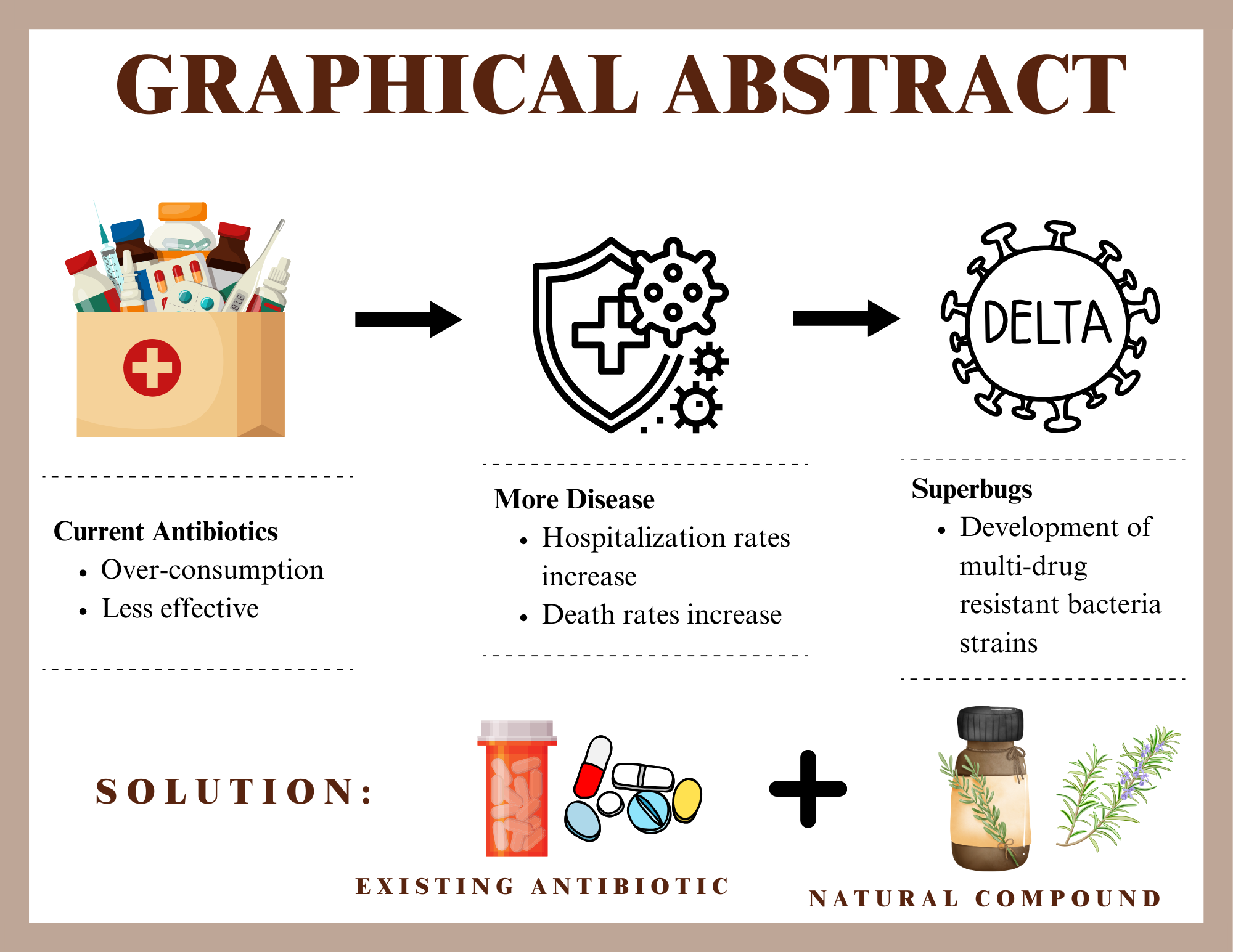
Project Proposal
Please click here to view my Project Proposal.
Phrase
Phrase One
How does the combination of either 1,8-cineole (Eucalyptol) or Naringenin with a subset of 11 antibiotics influence their efficacy, as measured by IC50?
Phrase Two
Due to prior exhibition of mechanisms of action similar to efflux pump inhibitors and outer membrane permeabilizers in natural compounds 1,8-Cineole (Eucalyptol) and Naringenin, it is hypothesized that synergistic interactions will occur in certain combinations of these compounds with antibiotics from various pharmacological classes, therefore validating their potential as antibiotic adjuvants.
Background
Background Infographic
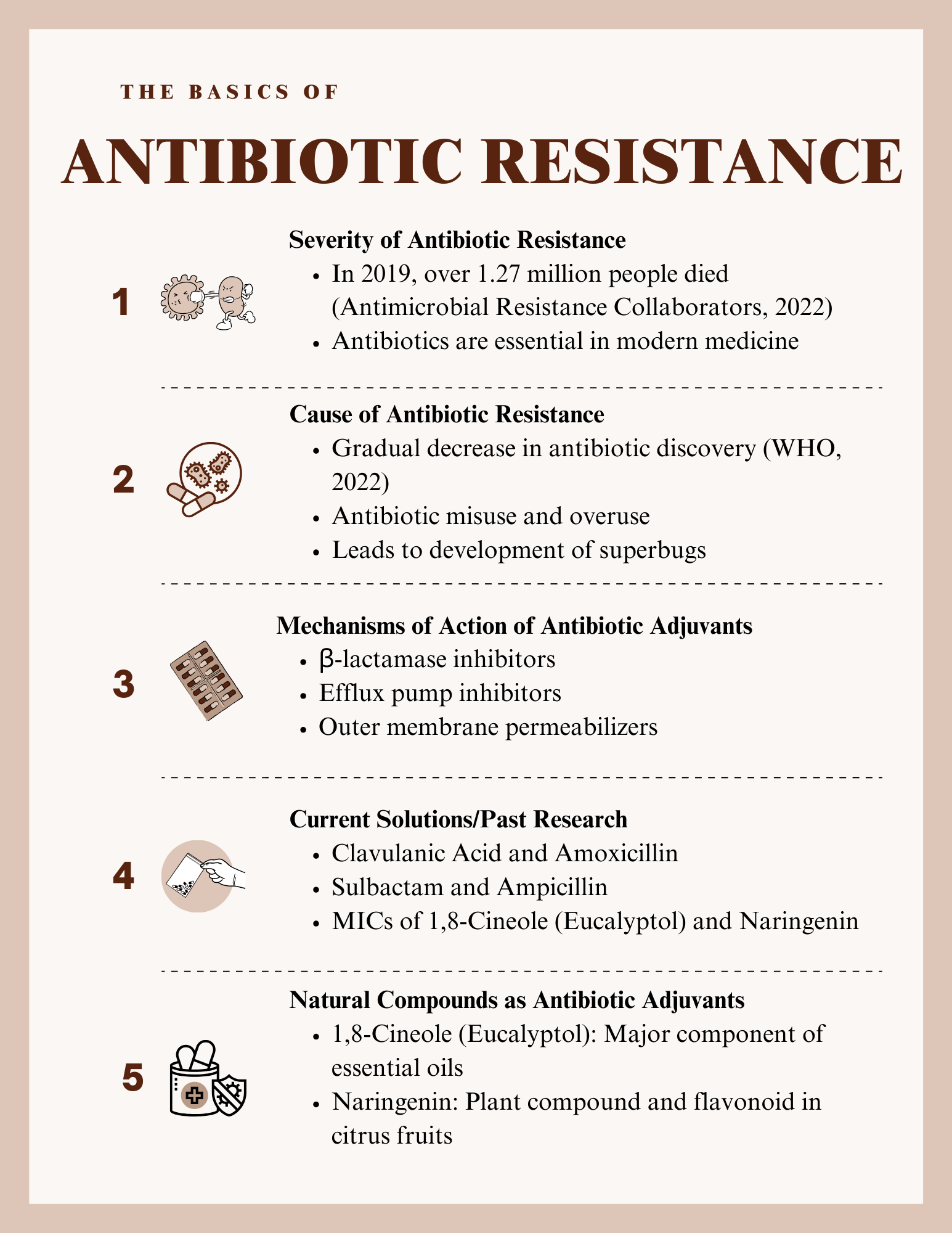
Background
Antibiotic resistance is a growing global health crisis, as overuse and misuse of antibiotics have led to the emergence of resistant bacteria, making previously treatable infections more difficult to manage. In 2019, antimicrobial resistance contributed to over 1.27 million deaths worldwide, with projections suggesting this number will rise without effective solutions. The slowdown in the discovery of new antibiotics has further exacerbated this issue, leaving healthcare systems vulnerable. To combat this, researchers are exploring alternative strategies, including the use of antibiotic adjuvants—non-antibiotic compounds that enhance the efficacy of existing antibiotics. Natural compounds, such as plant-derived molecules, show promise as adjuvants due to their antimicrobial properties and potential to complement antibiotic action by targeting bacterial structures or pathways critical for survival. By combining these compounds with antibiotics, it is hoped that synergistic effects can be harnessed, offering a new approach to addressing antibiotic resistance and improving treatment outcomes.
Procedure
Procedure Infographic


Procedure
In the first technique, Minimum Inhibitory Concentration (MIC) values for individual antibiotics and natural compounds are determined using a broth microdilution assay. Bacterial cultures are grown overnight, then inoculated into a 96-well plate with various concentrations of antibiotics and natural compounds in M9 media. The first row of the plate receives the highest concentration, with subsequent rows receiving two-fold serial dilutions of the antibiotic or compound. The final concentration range is determined for each compound. After adding the bacteria and incubating for 24 hours, the MIC is determined by assessing the lowest concentration where bacterial growth is inhibited.
In the second technique, the interaction between antibiotics and natural compounds is tested in a similar broth microdilution format. Antibiotics and natural compounds are diluted in a 96-well flat-bottom plate. Three set of wells receives just antibiotic dilutions, while 3 other sets receive a combination of multiple antibiotic concentrations and a single natural compound concentration. The bacterial inoculum is added to each well, and after incubating for 24 hours, bacterial growth is assessed. The results are analyzed to determine if the combination of antibiotics and natural compounds produces a synergistic or antagonistic effect by comparing growth in the combined treatment wells to those with individual compounds.
Figures




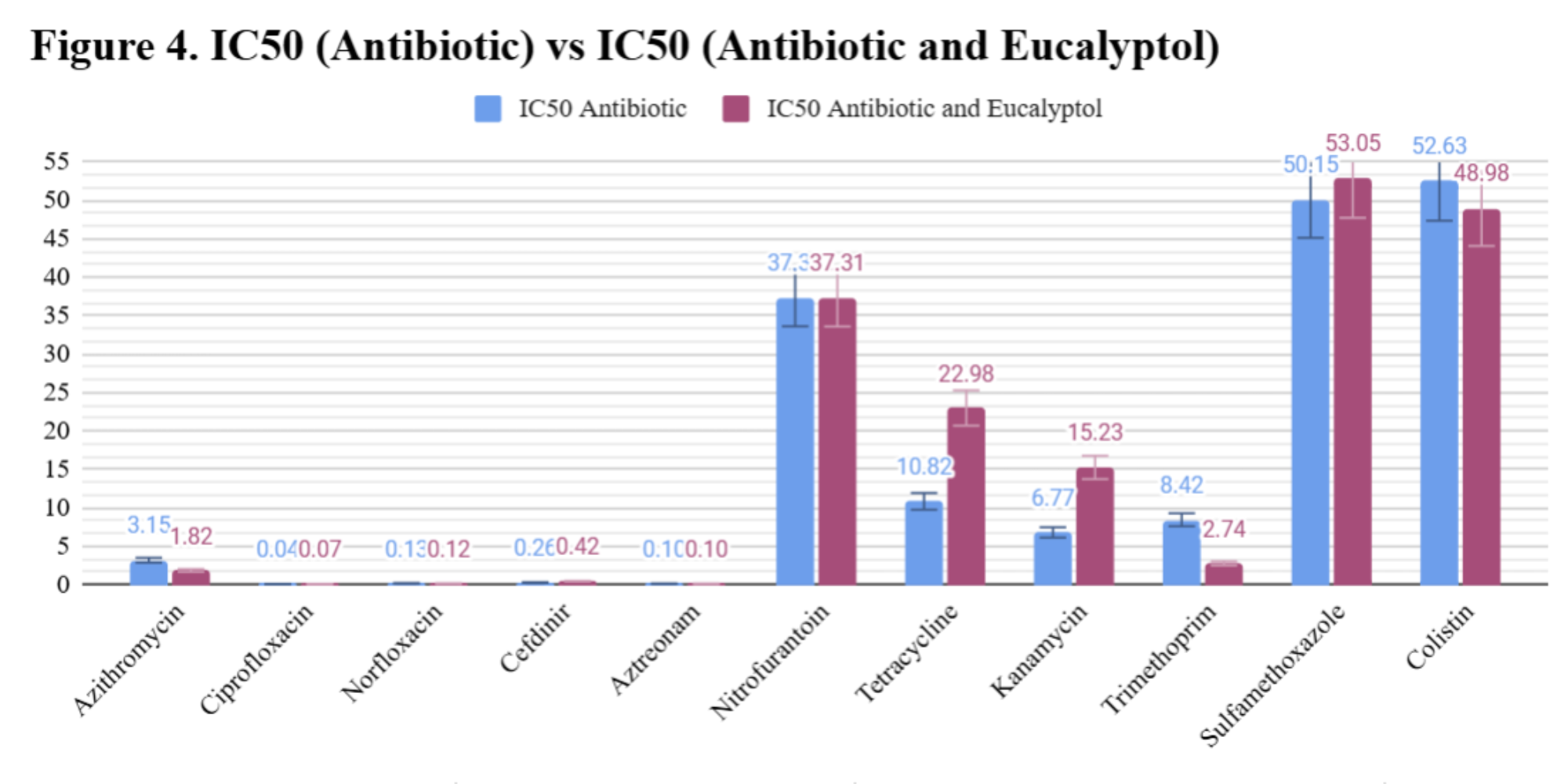
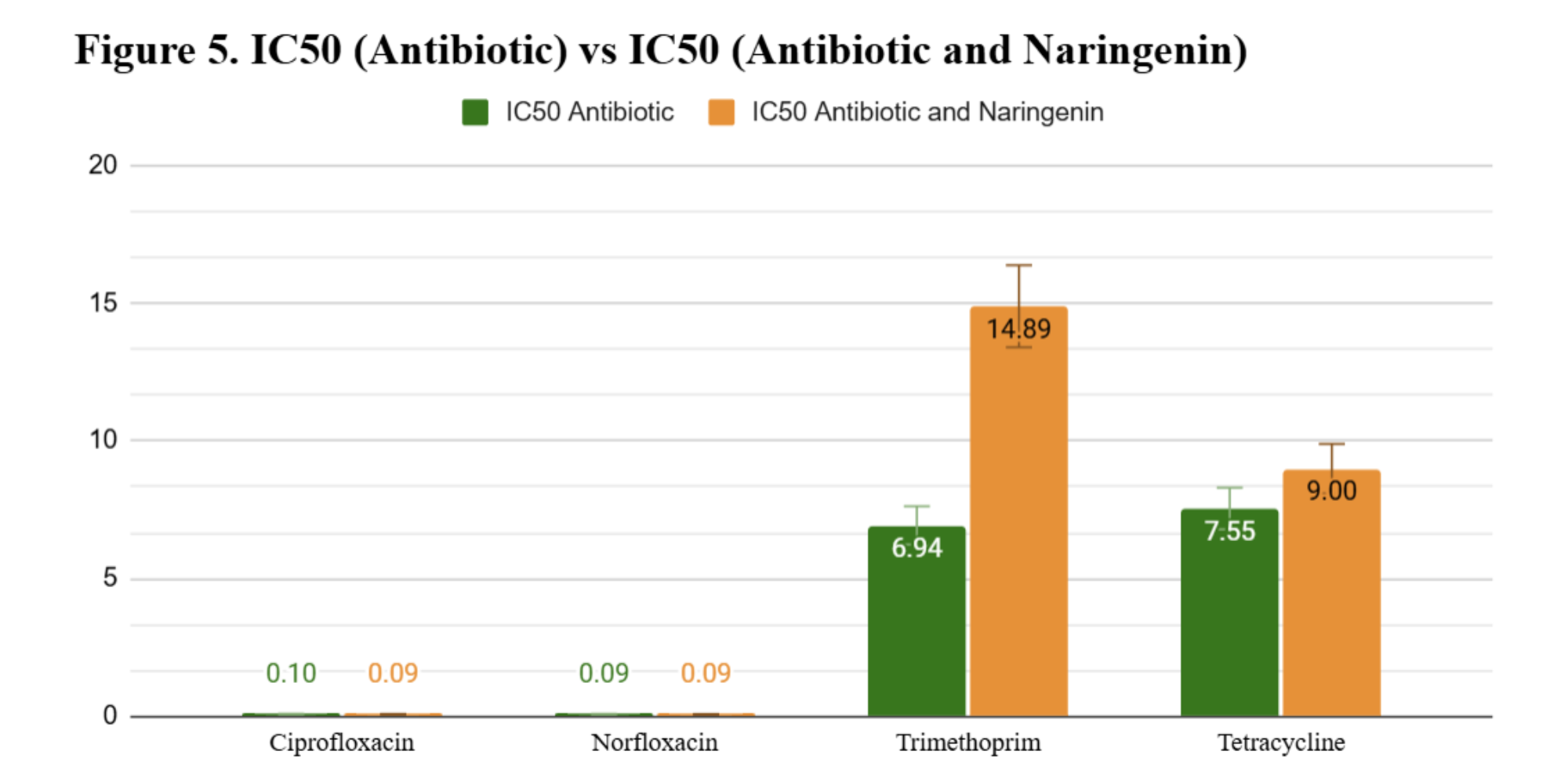
Analysis
Results indicate four novel relationships between the natural compounds Eucalyptol and Naringenin when combined with various antibiotics, demonstrating both synergistic and antagonistic interactions. A significant synergistic interaction was observed between Eucalyptol and Azithromycin, with a p-value of 0.0069, suggesting that the combination enhances the antibiotic’s effectiveness. In contrast, three antagonistic relationships were identified: Eucalyptol with Tetracycline (p = 0.048) and Kanamycin (p = 0.018), as well as Naringenin with Trimethoprim (p = 0.00062). These p-values indicate that these combinations reduce antibiotic efficacy, potentially due to interference in their mechanisms of action. The remaining antibiotic-natural compound combinations did not show statistically significant interactions, as their p-values were above typical significance thresholds, implying no strong synergistic or antagonistic effects. These findings suggest that Eucalyptol may function as an antibiotic adjuvant in specific cases, while also highlighting the need to screen for potential antagonistic interactions when developing combination therapies.
Discussion/Conclusion
Discussion and Conclusion
The findings from this study provide valuable insight into novel chemical combinations that have not been previously researched or published. The discovery of a synergistic relationship between Eucalyptol and Azithromycin suggests that Eucalyptol can function as an effective antibiotic adjuvant, enhancing the efficacy of Azithromycin against bacterial infections. This presents an opportunity for further research into Eucalyptol’s potential use in combination therapies to improve treatment outcomes and combat antibiotic resistance.
Conversely, three antagonistic interactions were observed: Eucalyptol with Tetracycline, Eucalyptol with Kanamycin, and Naringenin with Trimethoprim. These findings indicate that these natural compounds may interfere with the efficacy of certain antibiotics, potentially through mechanisms that enhance bacterial survival or resistance. While antagonistic relationships are generally considered undesirable in antibiotic development, these interactions warrant further exploration for potential applications, such as controlled bacterial growth in specific industrial or research settings.
Future research should focus on elucidating the molecular mechanisms underlying these synergistic and antagonistic effects. Gene analysis studies could help determine the specific genetic pathways influenced by these natural compounds when combined with antibiotics. For instance, transcriptomic and proteomic analyses could reveal which genes are upregulated or downregulated in response to these combinations, offering insights into resistance mechanisms, metabolic changes, or stress responses in bacterial cells. Additionally, studying mutations in key regulatory genes or transporters could help clarify how these compounds modulate antibiotic activity. Identifying these genetic interactions could provide new targets for therapeutic intervention and optimize the use of natural compounds in antibiotic treatments.
Overall, this study highlights the potential of natural compounds as antibiotic adjuvants and underscores the complexity of antibiotic interactions. Continued research in this area could contribute to the development of novel therapeutic strategies aimed at overcoming antibiotic resistance and improving the effectiveness of existing treatments.
References
February Poster
